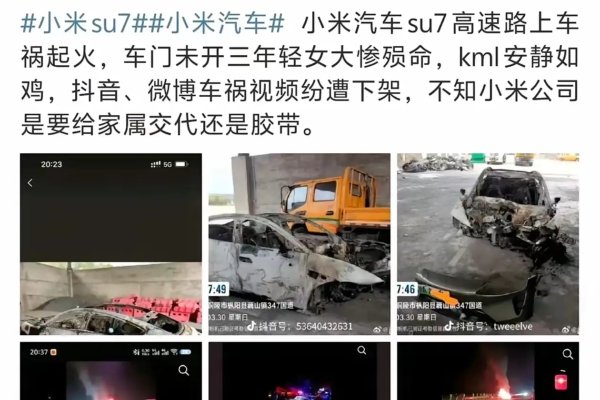Xiaomi SU7 Explosion Tragedy: 3 Dead, Investigation and Doubts Arise
On March 29, a Xiaomi SU7 vehicle collided and burst into flames on a highway in Anhui, resulting in the tragic deaths of 3 female university students. Following the incident, questions and concerns emerged regarding the cause of the accident and Xiaomi’s handling of the situation. Three days later, Xiaomi released a report on the accident. The company’s founder, chairman, and CEO, Lei Jun, who had remained silent prior, took to Weibo to announce that a special team had arrived at the scene on the 30th and cooperated with the police to provide vehicle data on the 31st. He also stated that they would “make every effort to address the concerns of the families and the society”.
However, Mr. Hu, one of the involved party and the boyfriend of one of the deceased, expressed doubts about the information submitted to the police by Xiaomi. As of April 1, Xiaomi’s working group had not contacted them, leading to Mr. Hu’s skepticism towards the information released by Xiaomi.
Mr. Hu revealed that upon hearing about the accident, he rushed from Guangdong to Xiangyang County in Anhui on March 30. Through communication with the boyfriends of the other two victims, he learned that his girlfriend had set off from Wuhan around 17:00 on March 29, and the group had taken two breaks en route to their destination. The accident occurred at 22:44 after their second rest stop.
According to Mr. Hu, his girlfriend was driving the vehicle that day. Prior to the incident, she had three years of driving experience. The Xiaomi SU7 involved in the accident was transferred to his girlfriend six months ago. Before the accident, she had driven over 10,000 kilometers and was considered a skilled driver.
On April 1 around 9 p.m., the father of one of the deceased in the incident questioned Xiaomi’s accident report concerning the “NOA (Intelligent Driving Assistance System) issuing a risk prompt of obstacles ahead, requesting deceleration.” He asked, “When did the car catch fire? How did the ignition affect the occupants? Could the doors open?”
Xiaomi responded late that evening to some of the public’s concerns. Regarding why the vehicle caught fire after the accident, Xiaomi stated that the investigation was ongoing but denied the claim of self-ignition. Xiaomi mentioned, “Based on current information, it can only be confirmed that the car caught fire after the accident and not as some claimed ‘self-ignition’, and it is speculated that the entire vehicle system suffered severe damage due to a violent collision with a cement barrier pile.”
As for whether the doors could open, Xiaomi said they had not yet accessed the accident vehicle, hence unable to analyze if the doors were operable during the accident.
In terms of the activation of active safety features like AEB during the incident, Xiaomi replied that after the NOA warning “attention obstacle,” deceleration was initiated, and approximately 1 second later, the driver took over, leading to the deactivation of the NOA system. The standard version of Xiaomi SU7’s front collision avoidance assistance system is limited to vehicles, pedestrians, and bicycles, currently not responsive to obstacles like traffic cones, bollards, rocks, or animals.
According to a report by “Concerned Citizens”, Xiaomi’s official information indicates that Xiaomi’s intelligent driving system consists of two solutions, Xiaomi Pilot Pro and Xiaomi Pilot Max. The standard version of Xiaomi SU7 is equipped with Xiaomi Pilot Pro intelligent driving system, featuring one NVIDIA DRIVE Orin chip, one millimeter-wave radar, 11 external cameras, and 12 ultrasonic radars but does not have a lidar sensor. Some intelligent driving technology experts suggest that due to the absence of a lidar sensor, the pure visual mode of the Xiaomi SU7 standard version may have inadequate obstacle recognition especially at night, leading to delayed obstacle identification issues.
However, ordinary users find it challenging to distinguish the specific differences between the two solutions of Xiaomi’s intelligent driving system, and their understanding of Xiaomi’s smart driving mostly comes from Lei Jun’s explanations in various scenarios about Xiaomi SU7’s intelligent driving.
For instance, Lei Jun mentioned in a live broadcast earlier this year that “within less than 10 months, Xiaomi’s intelligent driving team released 4 major versions, from high-speed NOA (Navigate on Autopilot) to urban NOA, then to mapless urban NOA, and finally to ‘end-to-end’ fully automated driving, fulfilling my requirement for them three years ago and propelling us into the top tier of the intelligent driving industry.”
During the recent Electric Vehicle Hundred-Person Forum (2025), Lei Jun also stated, “Every Xiaomi vehicle now uses end-to-end automatic driving.”

